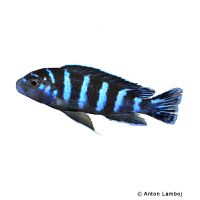Demason's Cichlid (Chindongo demasoni)
| Demason's Cichlid Chindongo demasoni | |
|---|---|
| Name | Demason's Cichlid |
| Name Lat. | Chindongo demasoni |
| Synonym | Pseudotropheus demasoni |
| Family | Cichlids |
| Family lat. | Cichlidae |
| Order | Cichlids |
| Order lat. | Cichliformes |
| Origin | Lake Malawi |
| Habitat | Rocky habitat |
| Diet | Omnivore, aufwuchs |
| pH | 7.5-8.8 |
| Behavior | Aggressive |
| Keeping | Harem |
| Care Level | Difficult |
| Reproduction | Mouthbrooder |
| Breeding | Simple |
| Life Span | 5-8 years |
| Protection | No |
| Metric Units | |
| Size | 8-10 cm |
| Temperature | 24-28 °C |
| Hardness | 10-25 °dH |
| Aquarium | ~ 300 l |
| US Units | |
| Size | 3"-4" |
| Temperature | 75-82 °F |
| Hardness | 178-445 ppm |
| Aquarium | ~ 80 gal |
Distribution and habitat
The distribution area of the Demasons mouthbrooders is exclusively (endemic) Lake Malawi, where they occur on the coast of Tanzania at the Pombo Rocks. They belong to the group of mbuna that lives in the rocky shore zones.
Maintenance
The aquarium setup should have rock structures reaching to the water surface, with many crevices, caves and shelters that serve as hiding places, as well as robust plants and some free sand areas. There should be no detectable ammonia, ammonium or nitrite, and the nitrate level should not exceed 100 mg/l. To ensure the water quality and oxygen content, a filter and heater adapted to the aquarium size is required, as well as lighting for the species-appropriate day-night rhythm of the animals.
Diet
They feed mainly on the plant cover (growth) and the microorganisms contained therein, as well as on plankton. The food supply consists of live, frozen and dry food. For a balanced diet, feed once daily with a high-quality dry food for Malawi cichlids (flakes, granules, pellets) as well as cyclops, daphnia, artemia and plankton (live or frozen). In addition, they also need vegetable food, such as algae leaves and commercially available green food (kelp, spirulina)
Only feed as much as will be eaten within a few minutes. A regular and varied diet promotes health and increases resistance.
Behaviour and compatibility
They are lively and assertive mbunas with high intraspecific aggression, occupying a large feeding territory and defending it vigorously. They should be kept in a harem, one male with several females or better in a large group. In this way social structures are formed which reduce quarrels. Keeping a group is only recommended in a much larger and richly structured tank. They can be socialized well with other robust cichlids from Lake Malawi, especially from the Mbuna group
Basically only compatible fish species with similar requirements should be socialized.
Sex dimorphism
The sexes are difficult to distinguish. The males are usually more intensely colored and slightly larger than the females.
Reproduction and breeding
They are maternal mouth brooders. Immediately after spawning, on a rock or in a small burrow, the females take the eggs into their throat sac for mouthbrooding. They keep the fry in their throat sac even after hatching. After about 4 weeks, the fry are released and brood care ends. During the entire brood care, the female does not take any food.
Fry must be fed several times a day with special rearing food (Artemia nauplii). In community tanks breeding is hardly possible, because the fry is easy prey.
Important
They are very sensitive to an improper diet and should be fed almost exclusively a high-fiber, plant-based diet
The well-being of the fish should be checked regularly. Temperature should be checked daily, pH, hardness and nitrate levels should be checked at least every 14 days. Regular partial water changes are recommended, even if the contaminant level has not yet reached the upper limit. Sudden changes in water quality should be avoided. Newly introduced fish must be accustomed slowly to the water in the aquarium.
Further literature can be found in your pet store.
References
Text: Sylvia Hos; Image: Anton Lamboj
Source: BMELV (1998): Tierschutzgutachten - Haltung von Zierfischen (Süßwasser); ENGELMANN (2005): Zootierhaltung - Tiere in menschlicher Obhut: Fische, Verlag Harri Deutsch
- Gemäß § 21 Abs. 5 Tierschutzgesetz idgF
